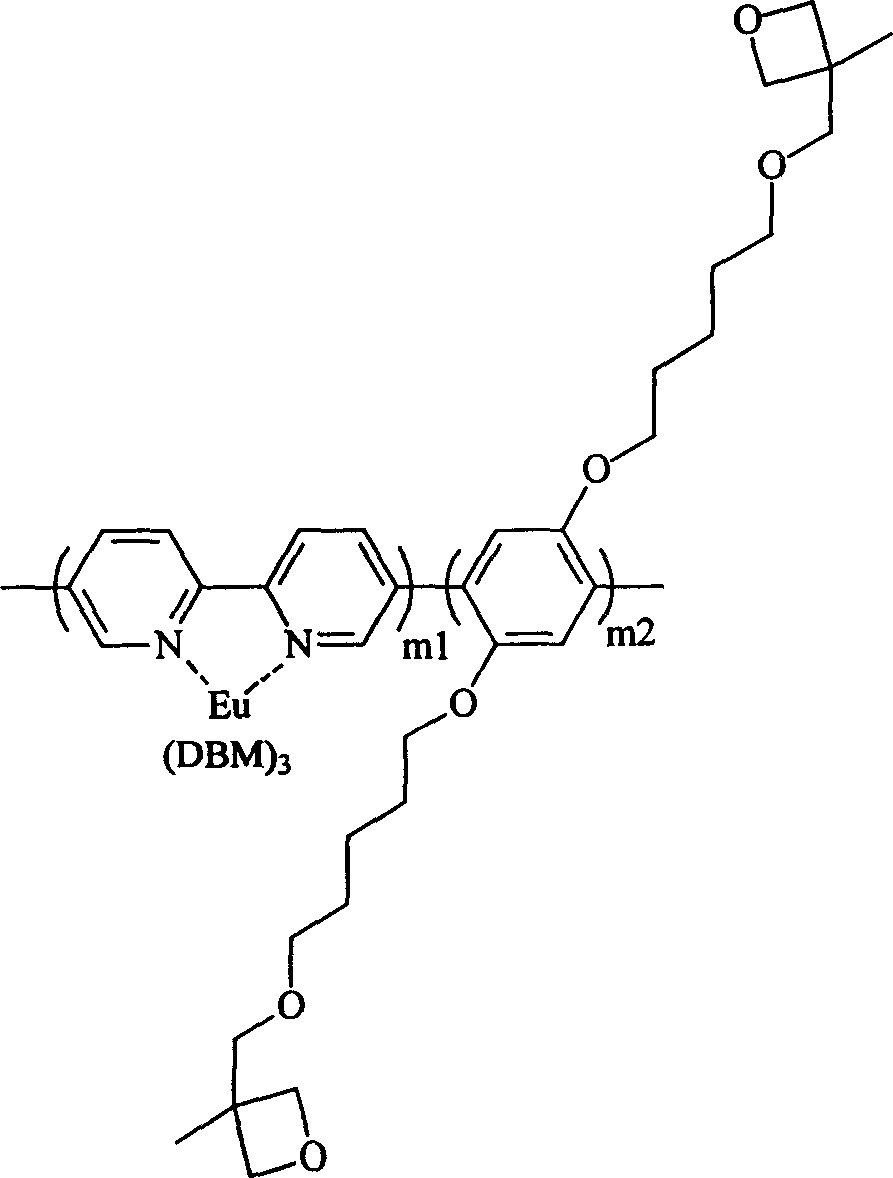Cross-linkable metallorganic macromolecular complex electroluminescent material and its making method
A metal-organic and polymer technology, applied in the direction of luminescent materials, chemical instruments and methods, etc., can solve problems such as phase separation and performance impact
- Summary
- Abstract
- Description
- Claims
- Application Information
AI Technical Summary
Problems solved by technology
Method used
Image
Examples
Embodiment 1
[0023] Select 5,5'-dibromo-2,2'bipyridine, 2,5-di-{6-[1-(3-methyl-oxabutan)yl-methoxy]-hexyloxy }-1,4-diboronic acid benzene as starting material, in Pd(PPh) 3 Suzuki reaction was carried out as a catalyst at a temperature of 90°C to prepare a random copolymer with a yield of about 78%. The ratio of copolymerized units m1:m2=1:1, the degree of polymerization n is about 20. Further with EuCl 3 Coordination was performed and the coordination number was saturated by the addition of dibenzoylmethanone (DBM) (compound I, structure shown below). The Eu polymer complex with this structure emits bright red light with a wavelength of 612nm detected by fluorescence spectroscopy.
[0024]
[0025]Compound I
Embodiment 2
[0027] Select 5,5'-dibromo-2,2'bipyridine, 9,9'-dioctyl-2,7-dibromofluorene, and 2,5-di-{6-[1-(3-methyl Base-oxabutanyl-methoxy]-hexyloxy}-1,4-diboronic acid benzene as starting material, in Pd(PPh) 3 Suzuki reaction was carried out as a catalyst at a temperature of 90°C to prepare a random copolymer with a yield of about 80%. The ratio of copolymerized units m1:m2:m3=1:1:4, the degree of polymerization n is about 12. Further with EuCl 3 Coordination was performed and the coordination number was saturated by the addition of dibenzoylmethanone (DBM) (compound II, structure shown below). The Eu polymer complex with this structure emits bright red light with a wavelength of 612nm detected by fluorescence spectroscopy. Compared with compound I, its luminescence intensity increased by about 30%.
[0028]
[0029] Compound II
Embodiment 3
[0031] Select tetrameric (2,2'-bipyridine-2,5-dioctyloxybenzene) (the terminal group is methoxy) as the starting material, and use the two-step reduction of methoxy to hydroxyl and hydroxyl Alkylation, synthesize bipyridine-benzene alternating oligomers (n=3) with epoxy groups at both ends, and after coordination reaction with europium chloride, add dibenzoyl ketone (DBM) to make rare earth The coordination numbers of the ions are saturated to give compound III. The Eu polymer complex with this structure emits bright red light with a wavelength of 613nm detected by fluorescence spectroscopy. Compared with similar Eu polymer complexes without epoxy groups, there is no difference, indicating that the crosslinking group has no obvious influence on the complexes. The synthetic steps of compound III are shown below.
[0032]
[0033] Compound III
PUM
| Property | Measurement | Unit |
|---|---|---|
| wavelength | aaaaa | aaaaa |
| degree of polymerization | aaaaa | aaaaa |
Abstract
Description
Claims
Application Information
 Login to View More
Login to View More - R&D
- Intellectual Property
- Life Sciences
- Materials
- Tech Scout
- Unparalleled Data Quality
- Higher Quality Content
- 60% Fewer Hallucinations
Browse by: Latest US Patents, China's latest patents, Technical Efficacy Thesaurus, Application Domain, Technology Topic, Popular Technical Reports.
© 2025 PatSnap. All rights reserved.Legal|Privacy policy|Modern Slavery Act Transparency Statement|Sitemap|About US| Contact US: help@patsnap.com



